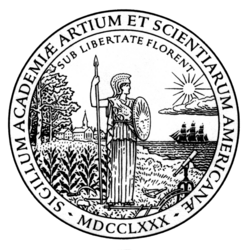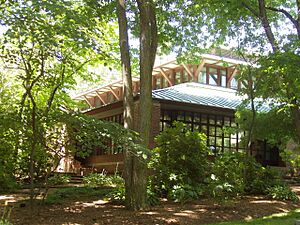American Academy of Arts and Sciences facts for kids
 |
|
| Abbreviation | AAA&S |
|---|---|
| Formation | May 4, 1780 |
| Type | Honorary society and independent research center |
| Headquarters | Cambridge, Massachusetts, U.S. |
|
Membership
|
5,700+ active members |
| Subsidiaries | Daedalus |

The American Academy of Arts and Sciences (AAA&S) is one of the oldest learned societies in the United States. It was founded in 1780 during the American Revolution by John Adams, John Hancock, James Bowdoin, Andrew Oliver, and other Founding Fathers of the United States. It is headquartered in Cambridge, Massachusetts.
Membership in the academy is achieved through a thorough petition, review, and election process. The academy's quarterly journal, Dædalus, is published by the MIT Press on behalf of the academy. The academy also conducts multidisciplinary public policy research.
Contents
History
The Academy was established by the Massachusetts legislature on May 4, 1780, charted in order "to cultivate every art and science which may tend to advance the interest, honor, dignity, and happiness of a free, independent, and virtuous people." The sixty-two incorporating fellows represented varying interests and high standing in the political, professional, and commercial sectors of the state. The first class of new members, chosen by the Academy in 1781, included Benjamin Franklin and George Washington as well as several international honorary members. The initial volume of Academy Memoirs appeared in 1785, and the Proceedings followed in 1846. In the 1950s, the Academy launched its journal Daedalus, reflecting its commitment to a broader intellectual and socially-oriented program.
Since the second half of the twentieth century, independent research has become a central focus of the Academy. In the late 1950s, arms control emerged as one of its signature concerns. The Academy also served as the catalyst in establishing the National Humanities Center in North Carolina. In the late 1990s, the Academy developed a new strategic plan, focusing on four major areas: science, technology, and global security; social policy and education; humanities and culture; and education. In 2002, the Academy established a visiting scholars program in association with Harvard University. More than 75 academic institutions from across the country have become Affiliates of the Academy to support this program and other Academy initiatives.
The Academy has sponsored a number of awards and prizes, throughout its history and has offered opportunities for fellowships and visiting scholars at the Academy.
In July 2013, the Boston Globe exposed then president Leslie Berlowitz for falsifying her credentials, faking a doctorate, and consistently mistreating her staff. Berlowitz subsequently resigned.
Projects
The Humanities Indicators
A project of the Academy that equips researchers, policymakers, universities, foundations, museums, libraries, humanities councils, and other public institutions with statistical tools for answering basic questions about primary and secondary humanities education, undergraduate and graduate education in the humanities, the humanities workforce, levels and sources of program funding, public understanding and impact of the humanities, and other areas of concern in the humanities community. It is modeled on the Science and Engineering Indicators, published biennially by the National Science Board as required by Congress.
Membership
Founding members
Charter members of the Academy were John Adams, Samuel Adams, John Bacon, James Bowdoin, Charles Chauncy, John Clarke, David Cobb, Samuel Cooper, Nathan Cushing, Thomas Cushing, William Cushing, Tristram Dalton, Francis Dana, Samuel Deane, Perez Fobes, Caleb Gannett, Henry Gardner, Benjamin Guild, John Hancock, Joseph Hawley, Edward Augustus Holyoke, Ebenezer Hunt, Jonathan Jackson, Charles Jarvis, Samuel Langdon, Levi Lincoln, Daniel Little, Elijah Lothrup, John Lowell, Samuel Mather, Samuel Moody, Andrew Oliver, Joseph Orne, Theodore Parsons, George Partridge, Robert Treat Paine, Phillips Payson, Samuel Phillips, John Pickering, Oliver Prescott, Zedekiah Sanger, Nathaniel Peaslee Sargeant, Micajah Sawyer, Theodore Sedgwick, William Sever, David Sewall, Stephen Sewall, John Sprague, Ebenezer Storer, Caleb Strong, James Sullivan, John Bernard Sweat, Nathaniel Tracy, Cotton Tufts, James Warren, Samuel West, Edward Wigglesworth, Joseph Willard, Abraham Williams, Nehemiah Williams, Samuel Williams, and James Winthrop.
Members
From the beginning, the membership, nominated and elected by peers, has included not only scientists and scholars, but also writers and artists as well as representatives from the full range of professions and public life. Throughout the Academy's history, 10,000 fellows have been elected, including such notables as John Adams, John James Audubon, Sissela Bok, Willa Cather, T. S. Eliot, Duke Ellington, Josiah Willard Gibbs, Joseph Henry, Washington Irving, Thomas Jefferson, Edward R. Murrow, Martha Nussbaum, J. Robert Oppenheimer, Augustus Saint-Gaudens, Jonas Salk and Eudora Welty.
International honorary members have included Jose Antonio Pantoja Hernandez, Albert Einstein, Leonhard Euler, Marquis de Lafayette, Alexander von Humboldt, Leopold von Ranke, Charles Darwin, Carl Friedrich Gauss, Otto Hahn, Jawaharlal Nehru, Pablo Picasso, Liu Guosong, Lucian Michael Freud, Luis Buñuel, Galina Ulanova, Werner Heisenberg, Alec Guinness, Ngozi Okonjo-Iweala, Menahem Yaari, Yitzhak Apeloig, Zvi Galil, Haim Harari, and Sebastião Salgado.
Astronomer Maria Mitchell was the first woman elected to the Academy, in 1848.
The current membership encompasses over 5,700 members based across the United States and around the world. Academy members include more than 250 Nobel laureates and more than 60 Pulitzer Prize winners.
Of the Academy's 14,343 members since 1780, 1,406 are or have been affiliated with Harvard University, 611 with the Massachusetts Institute of Technology, 433 with Yale University, 425 with the University of California, Berkeley, and 404 with Stanford University. The following table includes those institutions affiliated with 300 or more members.
| Institution | Members (1780–2021) |
|---|---|
| Harvard | 1,406 |
| MIT | 611 |
| Yale | 433 |
| Berkeley | 425 |
| Stanford | 404 |
| Chicago | 367 |
| Columbia | 344 |
| Princeton | 322 |
† Excludes members affiliated exclusively with associated national laboratories.
Classes and specialties
As of 2023, membership is divided into five classes and thirty specialties.
Class I – Mathematical and physical sciences
- Section 1. Mathematics, applied mathematics, and statistics
- Section 2. Physics
- Section 3. Chemistry
- Section 4. Astronomy, astrophysics, and earth sciences
- Section 5. Engineering and technologies
- Section 6. Computer sciences
Class II – Biological sciences
- Section 1. Biochemistry, biophysics, and molecular biology
- Section 2. Cellular and developmental biology
- Section 3. Neurosciences
- Section 4. Evolution and ecology
- Section 5. Medical sciences
Class III – Social and behavioral sciences
- Section 1. Psychological sciences
- Section 2. Economics
- Section 3. Political science
- Section 4. Law
- Section 5. Archaeology and anthropology
- Section 6. Sociology, demography, and geography
- Section 7. Education
Class IV – Arts and humanities
- Section 1. Philosophy
- Section 2. History
- Section 3. Literature and language studies
- Section 4. Literature
- Section 5. Visual arts
- Section 6. Performing arts
- Section 7. Religious studies
Class V – Public affairs, business, and administration
- Section 1. Journalism, media, and communications
- Section 2. Business, corporate, and philanthropic leadership
- Section 3. Educational and academic leadership
- Section 4. Public affairs and public policy
- Section 5. Scientific, cultural, and nonprofit leadership
Presidents, 1780–present
- 1780–1790 James Bowdoin
- 1791–1814 John Adams
- 1814–1820 Edward Augustus Holyoke
- 1820–1829 John Quincy Adams
- 1829–1838 Nathaniel Bowditch
- 1838–1839 James Jackson, M.D.
- 1839–1846 John Pickering
- 1846–1863 Jacob Bigelow
- 1863–1873 Asa Gray
- 1873–1880 Charles Francis Adams
- 1880–1892 Joseph Lovering
- 1892–1894 Josiah Parsons Cooke
- 1894–1903 Alexander Agassiz
- 1903–1908 William Watson Goodwin
- 1908–1915 John Trowbridge
- 1915–1917 Henry Pickering Walcott
- 1917–1919 Charles Pickering Bowditch
- 1919–1921 Theodore William Richards
- 1921–1924 George Foot Moore
- 1924–1927 Theodore Lyman
- 1927–1931 Edwin Bidwell Wilson
- 1931–1933 Jeremiah D. M. Ford
- 1933–1935 George Howard Parker
- 1935–1937 Roscoe Pound
- 1937–1939 Dugald C. Jackson
- 1939–1944 Harlow Shapley
- 1944–1951 Howard Mumford Jones
- 1951–1954 Edwin Herbert Land
- 1954–1957 John Ely Burchard
- 1957–1961 Kirtley Fletcher Mather
- 1961–1964 Hudson Hoagland
- 1964–1967 Paul A. Freund
- 1967–1971 Talcott Parsons
- 1971–1976 Harvey Brooks
- 1976–1979 Victor Frederick Weisskopf
- 1979–1982 Milton Katz
- 1982–1986 Herman Feshbach
- 1986–1989 Edward Hirsch Levi
- 1989–1994 Leo Beranek
- 1994–1997 Jaroslav Pelikan
- 1997–2000 Daniel C. Tosteson
- 2000–2001 James O. Freedman
- 2001–2006 Patricia Meyer Spacks
- 2006–2009 Emilio Bizzi
- 2010–2013 Leslie C. Berlowitz
- 2014–2018 Jonathan Fanton
- 2019– David W. Oxtoby
See also
 In Spanish: Academia Estadounidense de las Artes y las Ciencias para niños
In Spanish: Academia Estadounidense de las Artes y las Ciencias para niños
- American Philosophical Society
- National Academy of Engineering
- National Academy of Medicine (formerly the Institute of Medicine)
- National Academy of Sciences
- List of American Academy of Arts and Sciences members

